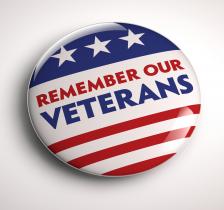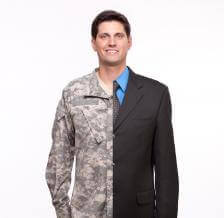7 Myths (and 1 Big Fact) About PTSD
In Part 1 of this series, you learned the 5 symptoms of PTSD. This week, the Savvy Psychologist talks about healing PTSD and the stigma that can get in the way, with a special emphasis on veterans from the wars in Iraq and Afghanistan.

Sponsor: Netflix Instant Streaming. Watch thousands of TV episodes and movies on your PC, Mac, iPad, iPhone or Touch. Or on your TV through your XBox, PS3 or Wii. All streamed instantly by Netflix, saving you time, money and hassle. For a free 30-day trial, including all 46 episodes of Breaking Bad, go to quickanddirtytips offers.
The idea for this series on PTSD comes from listener Phoebe Gavin of New York City. In addition to being an Iraq War veteran, Phoebe belongs to Iraq and Afghanistan Veterans of America (IAVA), the first and largest non-profit, non-partisan association for new veterans. Thank you, Phoebe, and all your fellow veterans, for your service.
While a 2011 Pew Research Center report revealed that a majority of Americans are apathetic or disapproving of the post-9/11 wars the military fought or is fighting, at the same time, Americans simultaneously feel “pride, gratitude, and confidence” towards the more than 2.6 million troops who have served in combat zones since 9/11. More than 90% are proud of the troops and about 75% have thanked a vet. And no matter your politics, I think we can all get behind less judgment and better health for veterans.
Almost 30% of Iraq and Afghanistan vets treated through the VA system are diagnosed with post-traumatic stress disorder (PTSD). But the stigma of having a disorder keeps many vets from seeking treatment, increases a sense of isolation, and perpetuates sensationalized media images. Worse, if left untreated, PTSD increases the risk for depression, drug and alcohol abuse, and suicide.
See also: 5 Signs of PTSD
So, to help lift the stigma, here are 7 myths about PTSD, refuted:
Myth #1: PTSD makes you violent and dangerous
Most media accounts of the recent Fort Hood shooting emphasize that Specialist Ivan Lopez was being evaluated for PTSD. Unfortunately, this propagates the falsehood that individuals with PTSD can snap at any time or go on Rambo-like rampages. Every time the media links PTSD or vets with violence, more vets push their struggles underground, try to go it alone, and don’t seek help.
As we learned in last week’s episode, 5 Signs of PTSD, the disorder includes hyperarousal, a group of symptoms that includes a tendency to be angry, irritable, on edge, and easily startled, which seems like a recipe for violence. However, it’s not an accurate picture. An important 2014 study followed over 1,000 veterans from all 50 states and all military branches for a year. Vets with PTSD who didn’t abuse alcohol didn’t have any higher risk of violence than vets with neither of those two difficulties.
The researchers concluded that when it comes to violence, we shouldn’t focus on PTSD alone, but instead on the cumulative effects of factors that reveal a more complex story: alcohol, history of violence before deployment, greater combat exposure, and not having enough money to cover basic needs after returning home. And even with all the risk factors, there’s no surefire recipe for violence; instead, the accumulation of stresses and vulnerabilities helps pinpoint who might need help, not who might be a danger.
Sadly, if anyone gets hurt, it’s most likely to be the person with PTSD himself or herself. The incidence of suicide in the Army has increased over the past several years, moving from below to above the rate of the general population. Indeed, of all suicides in the U.S., 1 in 5 is a veteran.
Myth #2: It’s OK to make small talk about traumatic experiences

Later, if you know the vet well and you’re willing to listen—really listen—to the answer, you can ask, preferably one-on-one, if they’d be willing to talk about their deployment.
Myth #3: You must have done something awful to get PTSD
Most of us are raised with a spoken or implied belief that good things happen to good people and bad things happen to bad people—a moral line in the sand. The belief that people get what they deserve, or what goes around comes around, is called the Just World Fallacy. It’s a fallacy because while we’d like to believe that good prevails and evil is punished, sometimes—oftentimes—it doesn’t work out so neatly.
The Just World Fallacy leads to a sense of security, but it’s a precarious security. It’s easier to fit the world into neat little categories of good and bad if we think that only bad people get killed, raped, addicted, or traumatized. But that line of thinking leads to blaming the victim. And it leaves folks with PTSD thinking they must have done something wrong to deserve this, or that it must be their fault.
The Just World Fallacy is a tough bubble to pop because it leaves us with the realization that the world isn’t fair. We’d like to believe in justice. We want to think that good guys win in the end. But sometimes bad guys get away and sometimes bad things—like trauma and PTSD—happen to the best people we know.
Myth #5: Well, at least you didn’t get hurt

A growing number of military officers and mental health professionals seek to reduce stigma by dropping the “D” from PTSD. Retired General Peter Chiarelli has been quoted as saying “No 19-year-old kid wants to be told he’s got a disorder.”
Likewise, Army Staff Sergeant Ty Carter, who received the Medal of Honor, has led the charge to change the name to PTS. Because it’s the only psychological condition that must be caused by an outside event, Carter and others aim to instill hope, increase willingness to get treated, and reduce stigma by changing the concept from that of a disorder to that of an injury—more like a broken leg or shrapnel wound than a mental illness.
Myth #5: All vets come back with PTSD or psychological damage
All vets are shaped by their experiences, but it’s usually in a positive way. According to the Pew study, over 90% of vets say their time in the military helped them mature, taught them how to work with others, and helped build self-confidence.
Unfortunately, the myth that vets are damaged is a common assumption and may be largely to blame for the high levels of unemployment among Iraq and Afghanistan vets. Indeed, a 2011 survey found that over 40% of hiring managers were “less favorable” toward hiring military personnel when they considered war-related psychological disorders.
The misconception of being unbalanced goes beyond those with PTSD to include all returning vets. For example, Phoebe Gavin, the listener and OIF veteran who suggested the topic for this episode, was asked at a job interview for a retail position how she might deal with shoplifters. She gave a thoughtful, appropriate answer, to which the interviewer responded, “Are you sure your combat training wouldn’t kick in?” The question implied that she might snap and be unable to control her violent impulses. On the contrary, she notes, combat training is all about controlling impulses—it’s about staying calm and making quick decisions, not about kicking butt and taking names.
Myth #6: Getting treatment will hurt my career

However, it’s actually the opposite. A 2006 study of active duty Air Force members found that only 3% of those who sought out mental health treatment perceived that it negatively impacted their careers. By contrast, of those who waited until their commanders referred them for treatment, 39% reported their careers were hurt. Careers don’t suffer when you get help, they suffer when PTSD goes untreated and gets in the way of doing your job.
Myth #7: You’re in this alone
This is not at all what the old Army recruiting slogan, “An Army of One,” meant. By contrast, PTSD is fairly common: 6-8% of Americans, not just veterans, will develop PTSD in their lifetime.
Many vets who don’t have full-blown PTSD may experience the flavor of PTSD in their post-deployment readjustment. For instance, many vets aren’t comfortable sitting with their back to a door or being in a crowded public space.
Among veterans of earlier eras, like Desert Storm or Vietnam, 16% say they suffered from post-traumatic stress, whether or not they received a diagnosis. In post 9/11 vets, the number jumps to 37%. The exact reasons for this increase are unclear, but it’s possible that pieces of the puzzle include improved screening, increased awareness, and weakening stigma. Regardless, no vet should struggle alone. Each person who talks about his or her experience with PTSD paves the way for others to do the same. And talking, simple as it is, is the best way to heal, which brings us to our big and hopeful truth about PTSD:
Truth #1 (or perhaps, the #1 Truth): PTSD is treatable
How do you get over PTSD? A great analogy is that your life is written as a book. Understandably, you don’t want to read the pages on which your traumas are written, but by skipping those pages, the story no longer makes sense. Plus, because your brain needs to make sense of the story, it keeps flipping back to those pages. Only by reading those pages word by word can the story make sense and the page-flipping stop.

To sum up, trauma does more than bend us; it breaks us. But then we mend, and while we always emerge changed by trauma, sometimes we emerge stronger, deeper, or more resilient than we ever thought possible.
References
https://www.pewsocialtrends.org/2011/10/05/war-and-sacrifice-in-the-post-911-era/
https://www.publichealth.va.gov/docs/epidemiology/ptsd-report-fy2012-qtr3.pdf
https://backhome.news21.com/article/suicide/
https://www.apa.org/monitor/2009/06/stigma-war.aspx
Elbogen, E.B., Johnson, S.C., Wagner, H.R., Sullivan, C., Taft, C.T. & Beckham, J.C. (2014). Violent behavior and post-traumatic stress disorder in U.S. Iraq and Afghanistan veterans. British Journal of Psychiatry, epub ahead of print.
Mittal, D., Drummond, K.L., Blevins, D., Curran, G., Corrigan, P. & Sullivan, G. (2013). Stigma associated with PTSD: Perceptions of treatment-seeking combat veterans. Psychiatric Rehabilitation Journal, 36, 86-92.
Nock, M.K., Stein, M.B., Herringa, S.G., et al; Army STARRS Collaborators. Prevalence and correlates of suicidal behavior among soldiers: Results from the Army Study to Assess Risk and Resilience in Servicemembers (Army STARRS). JAMA Psychiatry. doi:10.1001/jamapsychiatry.2014.30.
Rowan, A. & Campise, R. (2006). A multisite study of Air Force outpatient behavioral health treatment-seeking patterns and career impact. Military Medicine, 171, 1123-1127.
Schoenbaum, M., Kessler, R.C., Gilman, S.E. et al; Army STARRS Collaborators. (2013). Predictors of suicide and accident death in the Army Study to Assess Risk and Resilience in Servicemembers (Army STARRS). JAMA Psychiatry. doi:10.1001/jamapsychiatry.2013.4417.
Disclaimer: All content is strictly for informational purposes only. This content does not substitute any medical advice, and does not replace any medical judgment or reasoning by your personal health provider. Please always seek a licensed physician in your area regarding all health related questions.
Veteran button and military man images courtesy of Shutterstock.






